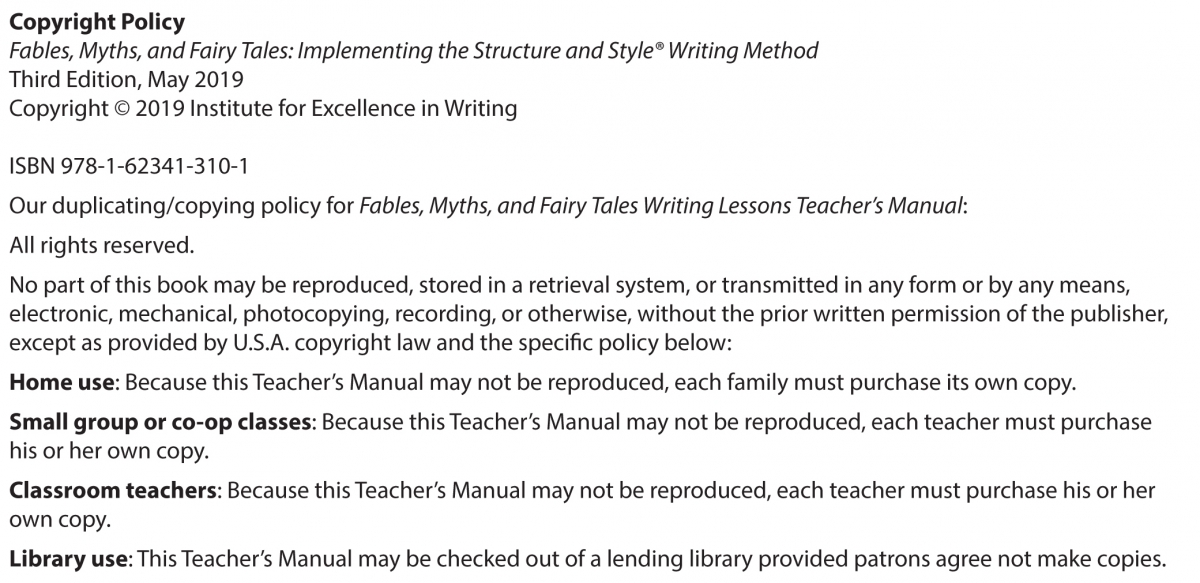
With the power of the Internet, physical distances are no longer a barrier. Information is instantly at our fingertips. While this has both positive and negative implications, undoubtedly one of the positives out there is that people from across the globe can be brought together instantly. One of the ways we see this happen is with online tutoring. Students who live in rural areas or who need access to specialized instruction are able to find competent tutors online who are able to help them learn, all within the comfort of their own home.
In this first post of a two-part blog, I would like to share how tutors can effectively tutor with IEW curriculum while still honoring the company’s copyright policies. For this post I will cover the following:
- where to find IEW’s copyright policies for the curriculum you’ve selected,
- what materials the tutor and the student will need to purchase,
- how to verify that the student has the materials he or she needs,
- how to use your online “whiteboard” to teach IEW to your student, and
- whether or not to assign homework.
In addition to working as a blog writer and homeschool educational consultant for IEW, I tutor students in both IEW and Barton Reading and Spelling. When I began tutoring years ago, I worked with students in person, either at a co-op, in their homes, or in mine. Teaching and tutoring in person is a great way to share IEW with your local community, but the Internet has made it possible to reach beyond our close environs to touch students’ lives all around the world. Over the past few years, I have been doing just that—working with students outside of my community to help them become better communicators and thinkers.
Today I want to share how I tutor with IEW online so that I can empower other tutors to consider reaching beyond their immediate communities as well. Teaching students using IEW methodology and materials can be done very successfully, but you need to be mindful of a few things. This first blog post will address how you can successfully tutor with IEW while honoring IEW’s copyright policies. In the second blog post, I will share what programs and equipment I use to make tutoring easy and fun.
IEW has very generous copyright policies, but it is important to be mindful of them and not overstep their bounds. When I work with online students, I will typically use either the Writing Source Packet or one of our excellent theme-based writing courses, with each student purchasing his own copy. I have also on occasion simply used the knowledge I have gained through Teaching Writing: Structure and Style to cultivate my own lessons.
If you have decided to use one of IEW’s programs, before beginning it, take a moment to locate the page detailing the copyright policy. I think examples are useful, so I’ll use one of the books I’m using with one of my classes to illustrate. I currently have a delightful little class of three students to whom I am teaching writing, using Fables, Myths, and Fairy Tales. I absolutely love teaching out of this book and find it to be a great introductory course for Level A students. As always, every IEW instructor should have worked through the teacher course, Teaching Writing: Structure and Style, prior to meeting with students.
When I open the Teacher’s Manual, near the beginning of the book, I see this page containing the copyright policies:

Since I am teaching a small group/co-op class, I follow the policy that is listed there: “Because this Teacher’s Manual may not be reproduced, each teacher must purchase his or her own copy.” Similarly, the Student Book states this: “Each participating student or family is required to purchase a Student Book. A teacher may not copy from this Student Book.” Copying includes sharing images from the book in an online environment.
What this means is that I need to verify that each of my students has his or her own book for the course. Students who are participating who live in the same family may share, but that’s the only provision that allows copying the Student Book at all. And those copies must stay within that family and cannot be shared online by me or anyone else.
Verifying that each student has his or her own copy is super easy. I simply have them hold up their books each session so I can visually verify that they have them. Not only does this work to verify I’m following IEW’s copyright policies, I am also verifying that my students are ready to get to work! Incidentally, if you ever want to see the copyright policy for any of IEW’s materials, you can go to the product page and click on the “Details” tab, which is between the “Overview” and “Samples” tabs. It will provide the same information that is found on the Copyright Policy page in the text.
Once I verify that each student has his or her own text, we are ready to begin! I will pull up a visual “whiteboard” (typically a Google Doc) that I share with my students. I like to prepare it ahead of time for the class I’m teaching by inserting an image that relates to the topic I’m teaching on. I don’t use the images in the actual text because they are copyright protected. Recently I taught a Unit 2 lesson on the Aesop fable, “The Ants and the Grasshopper.” To source an image, I went online and found the Library of Congress copy of Milo Winter’s beautiful book, Aesop for Children, and sourced one from there since it’s in the public domain.
In addition to including a fun image in the whiteboard space, I will create a general outline of our brainstorming tasks for the day. It might have something like this indicated:
Review
New Style
Class Outline:
I.
1.
2.
3.
4.
(5.)
Brainstorming
Vocabulary
This framework helps me to keep the lesson moving and not forget any important elements. Review may include going over banned words, talking about previously learned vocabulary, or asking the students questions about the key word outline format or other elements of Structure and Style®. In short, I go over whatever I think my students need strengthening in.
I want to reiterate that I never include actual images of the student pages of the text. This includes the sources. The students already have them in their own books. So instead I will read the source aloud while they follow along in their books, and then my class and I brainstorm together to create an outline that I write on our “whiteboard.”
When deciding whether I should share something online or not, I consider how I would handle it in a live, in-person class. I would never write out the entire source on my whiteboard, but I would brainstorm with my class after I’ve read it aloud so that I can use the “Robin Hood method,” stealing from the linguistically rich to aid my students who are more linguistically impoverished.
When I conclude teaching my class, I email a copy of the whiteboard work that my students and I collaborated on for their reference and post it in our online classroom space. I also allow my students who come to me in person to take a photo of my whiteboard, so this mimics that benefit for my remote students.
One thing I haven't touched on yet pertains to IEW's video courses such as Structure and Style for Students. It is very important to note that you may not share the video content in any way online. Does this mean you can’t teach these courses in an online format? Not at all! Rather, just as you would require your students to purchase their own Student Book for any theme-based course, you would have the student purchase their own copy of the Student Writing Intensive course. They would watch the video at home prior to class, and then you would facilitate the class online by working through the content with them.
You might also be wondering about whether or not to assign homework to your student. I have handled it in multiple ways, depending upon my students’ personal situations. When I teach classes online, I handle them just as if they were in a live classroom. I teach and model the lesson and then assign them work to complete throughout the week, which they then share with their editor before they send it to me. For my students with learning differences, I usually don’t assign homework. Some of these students are already receiving plenty of homework at their schools and struggle enough with completing that. Instead I work with them using an EZ+1 approach to help them advance their written expression skills during our sessions with minimal to no homework assignments. It just depends upon what each student’s needs are.
I hope this blog post has helped you gain a better grasp of how you can implement IEW with your remote students while still honoring IEW’s copyright policies. In my next post, I look forward to sharing with you some of the tools I use to make tutoring easy and fun for tutors and students alike. Do you still have questions? Contact us! We are happy to help you navigate our policies.
|
Jennifer Mauser has always loved reading and writing and received a B.A. in English from the University of Kansas in 1991. Once she and her husband had children, they decided to homeschool, and she put all her training to use in the home. In addition to homeschooling her children, Jennifer teaches IEW classes out of her home, coaches budding writers via email, and tutors students who struggle with dyslexia. |

